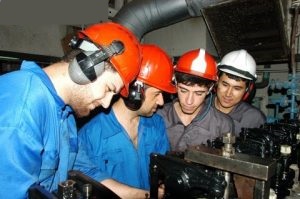Effective ship operations and maintenance are fundamental to ensuring the safety, efficiency, and longevity of maritime vessels. For ship engineers, cadets, officers, and seafarers, a comprehensive understanding of machinery operation, maintenance protocols, and troubleshooting techniques is essential. Modern ships are equipped with complex machinery and systems, including propulsion engines, electrical generators, navigation equipment, and auxiliary systems. Familiarity with these components is crucial for effective operation and maintenance.
Operation of Ship Machinery
Operating ship machinery correctly is crucial to vessel performance and safety. Here’s an expanded look at some key practices for effective machinery operation:

Adherence to Manufacturer Guidelines: Every piece of equipment onboard has unique specifications and operational instructions provided by the manufacturer. Following these guidelines is essential not only for achieving optimal performance but also for preventing unnecessary wear and avoiding mishandling. For example, main engines, auxiliary engines, and other critical machinery often have temperature and pressure limits that must be strictly observed. Overriding any set parameters or pushing machinery beyond its capacity can lead to mechanical failures, expensive repairs, and potentially hazardous situations. Keeping up with manufacturer updates and service bulletins can also ensure that operators are aware of any adjustments or recommended maintenance actions.
Regular Monitoring of Key Parameters: Continuous monitoring of machinery parameters is essential. Parameters like temperature, pressure, flow rate, and vibration levels provide insight into the current condition of the equipment. Deviations from normal values can indicate wear, potential faults, or performance degradation. Monitoring systems often include alarms that notify operators of issues before they escalate into larger problems. Utilizing monitoring systems such as engine performance monitors, oil analyzers, and vibration sensors allows engineers to detect irregularities in real-time. For instance, increased vibration may suggest misalignment or worn-out components, while unusual temperature spikes could point to lubrication issues.
Training and Competence: Effective operation of ship machinery demands a high level of expertise and competence. Training programs should be rigorous and cover both theoretical knowledge and hands-on practice. Operators must understand the functionality of each system and be prepared to respond to potential issues. Regular training sessions, simulator exercises, and competency evaluations help ensure that all personnel are well-prepared. The International Safety Management (ISM) Code emphasizes the need for skilled personnel to handle machinery, and having adequately trained crew reduces the risk of accidents and contributes to efficient operations.
System Optimization for Efficiency: Modern ships are equipped with automation and control systems that allow for optimized operations. These systems adjust fuel flow, speed, and other parameters based on current operating conditions. By using these systems effectively, operators can enhance fuel efficiency and reduce wear on machinery components. For instance, during low-load conditions, some systems can automatically reduce power consumption. Understanding and utilizing these optimizations can extend machinery lifespan and lead to cost savings in fuel and maintenance.
Maintenance Strategies in Ship Operations
Maintenance is an essential pillar of ship management, ensuring machinery reliability, safety, compliance, and operational efficiency. The proper implementation of maintenance strategies minimizes downtime, prolongs the lifespan of critical equipment, and aligns with international standards. This article explores an integrated approach to maintenance strategies, drawing insights from classification societies, the IMO, shipping companies, and maritime literature.

1- Planned Maintenance Systems (PMS)
The Planned Maintenance System (PMS) is the backbone of maintenance strategies in the maritime industry. It encompasses all forms of pre-arranged maintenance, including both preventive and condition-based tasks, ensuring compliance with regulatory frameworks such as the ISM Code and SOLAS requirements.
Key Features
- Scheduled Tasks: PMS ensures routine checks, lubrication, part replacements, and system overhauls are performed at predetermined intervals, as recommended by Original Equipment Manufacturers (OEMs) and classification societies like DNV or Lloyd’s Register.
- Digital Tools: Modern PMS platforms, such as those provided by companies like ABS Nautical Systems or Wärtsilä, enable efficient tracking, reporting, and compliance audits.
- Flexibility: Maintenance tasks are strategically planned to coincide with port calls, reducing operational disruptions.
Example in Practice: For instance, an oil filter replacement for a main engine can be scheduled during a drydock or port stay. Routine inspection of pumps and cooling systems ensures optimal performance, aligning with the ship’s operational schedule.
2- Condition-Based Maintenance (CBM)
Condition-Based Maintenance (CBM) is a proactive approach within the PMS framework that leverages real-time monitoring to optimize maintenance efforts. Instead of fixed schedules, CBM relies on the actual condition of machinery.
Key Components
- Monitoring Parameters: Vibration, temperature, oil quality, and wear particle analysis are key indicators monitored by advanced sensors.
- Diagnostic Tools: Technologies like infrared thermography and ultrasonic testing help detect anomalies before they escalate.
- Predictive Analytics: By analyzing trends in sensor data, predictive models can forecast potential failures.
Benefits: CBM reduces unnecessary maintenance tasks and avoids costly failures. For example, vibration analysis may indicate a misaligned pump, prompting immediate corrective action. Similarly, oil analysis can detect metal particles, signaling wear in engine components.
3- Emergency Maintenance
While PMS and CBM aim to prevent failures, unforeseen breakdowns require immediate action through emergency maintenance (break-down maintenance) . This reactive strategy ensures minimal downtime and operational continuity.
Preparedness: Shipping companies, such as Maersk and MSC, emphasize the importance of stocking spare parts and training personnel for rapid response. Spare part management systems, often integrated with PMS platforms, play a critical role in this readiness.
Real-World Example: A sudden failure in a generator during a voyage could lead to operational delays. However, having trained engineers and necessary spare parts onboard enables prompt repairs, restoring functionality without significant disruptions.
Documentation and Compliance in Ship Maintenance
Thorough documentation is essential for regulatory compliance and trend analysis in ship maintenance.
- Regulatory Compliance: Maintenance logs ensure adherence to standards set by classification societies, flag states, and international conventions like SOLAS and the ISM Code.
- Trend Analysis: Historical data helps identify recurring issues and refine maintenance strategies, such as pinpointing operational stress in frequently failing components.
Digital platforms like ABS Nautical Systems and DNV’s ShipManager simplify record-keeping, enabling real-time updates, easy access during audits, and integration with Condition-Based Maintenance (CBM) tools. These solutions enhance efficiency, support predictive maintenance, and streamline compliance processes. Accurate records are both a regulatory requirement and a driver of continuous improvement, ensuring operational excellence in the maritime industry.
Future Trends in Ship Maintenance
The maritime industry is increasingly adopting advanced technologies to enhance maintenance practices:
- Artificial Intelligence (AI): Predictive maintenance powered by AI improves decision-making by analyzing historical data and predicting failures.
- Automation and Robotics: Automated inspection systems, such as drones for hull inspections, reduce the need for manual checks.
- Sustainability Focus: Maintenance strategies now integrate environmental considerations, such as compliance with MARPOL Annex VI.
A well-designed maintenance strategy is crucial for the safe, efficient, and sustainable operation of ships. Integrating Planned Maintenance Systems with advanced tools like CBM and predictive analytics ensures optimal performance and regulatory compliance. By leveraging modern technologies and adhering to international standards, the maritime industry continues to innovate and enhance maintenance practices.
Ensure all operations and maintenance activities comply with international regulations, including the ISM Code and MARPOL Convention, to promote safety and environmental protection. Stay updated with the latest advancements in maritime technology and best practices through continuous education and training programs. This proactive approach enhances competence and ensures adherence to evolving industry standards. By integrating these practices into daily operations, maritime professionals can significantly enhance vessel performance, safety, and reliability, contributing to the overall success of maritime operations.
Sources: IMO MEPC reports, Wärtsilä’s AI-driven maintenance solutions, and publications from Marine Technology Reporter.


